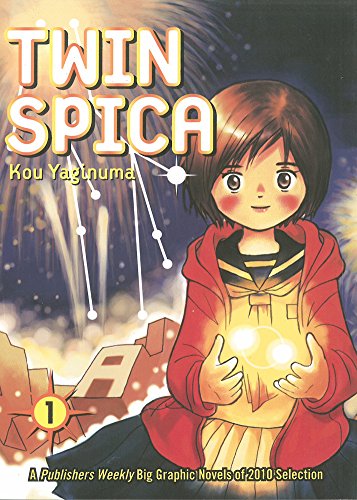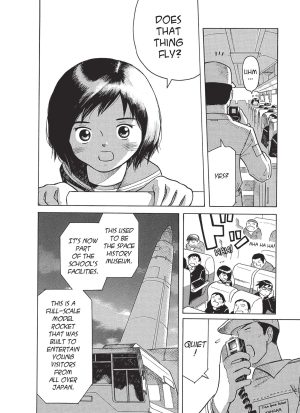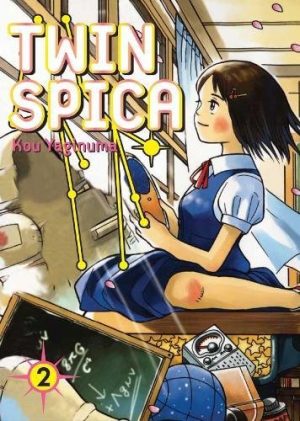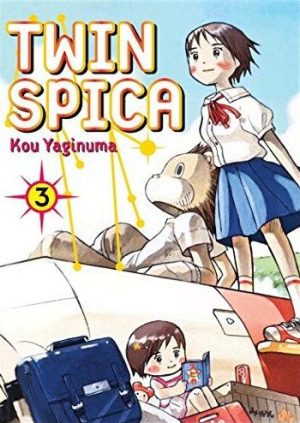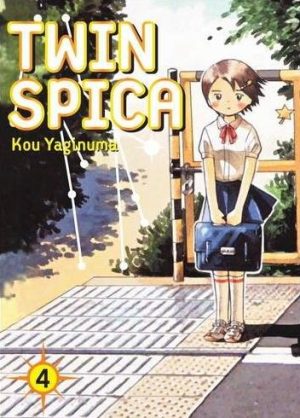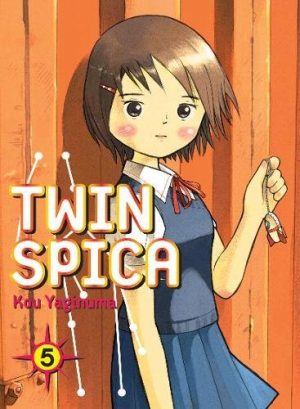Review by Win Wiacek
The mystery and imagination of space travel, so much a component of immediate post-World War II industrial society, returns in all its resplendent wonder and glory in Kou Yaginuma’s Twin Spica. It expands his earlier poignant short story into a longer epic combining hard science and fiction with lyrical mysticism and traditional school days growth pangs
In 2024 Asumi Kamogawa is a teenager who has always dreamed of going into space. From her earliest moments the lonely child has gazed up at the stars with her imaginary friend Mr. Lion, staring at the heavens, and especially at the twinkling glow of Virgo and the alluring binary star Spica. An isolated, serious child, she lives with her father, a labourer who once worked for the consortium that built rockets for the Japanese space program.
The program ended with a disaster in 2010, when Asumi was a year old. Hundreds were killed and injured, including Asumi’s mother. Maimed and comatose, she took years to die and the trauma broke her grieving husband and utterly traumatised the infant Asumi.
In response to the disaster Japan founded an astronaut and space sciences training school and as the first volume opens Asumi discusses with her imaginary friend the best way to tell her dad that she has secretly taken the entrance exam. Tomoro Kamogawa is a no fan of the space program, having lost his wife, his engineering job and his pride to the race for space. He has raised his daughter alone by working two and often three menial jobs at a time for over a decade.
The problem is taken out of Asumi’s hands when he opens her results letter and learns she’s been accepted for the next intake for the Tokyo National Space School. After initial resistance he surprises Asumi by not only allowing her to go, but also by donating his savings to pay her expenses. It’s only enough to rent in the dilapidated campus dormitory, and there’s a surprise on discovering Shinnosuke Fuchuya, the boy who teased and bullied her all through school, has also been accepted for the course. He’ll do anything other than run the family fireworks shop.
The course is heavily over-subscribed so candidates are winnowed out by spending the first week in adaptability stress trials: three to a room, in complete isolation, taking mental and physical tests to determine how they would cope with conditions similar to an extended stay in a space capsule. Tiny Asumi (only four feet, eight inches tall) is placed with the jolly Kei Oumi and chilly, acerbic Marika Ukita whilst Fuchuya’s team is cursed with spooky, ultra-cool style-icon Shu Suzuki. It quickly becomes clear the tests are actually designed to measure not just their survival capabilities but also their ability to get on in a crisis.
This first volume includes Yaginuma’s painfully powerful introductory story in which Asumi is a troubled little girl who’s always running away and even steals the ashes of her mother. Another prequel tale shows the miserable, melancholic period immediately following the disaster.
Twin Spica ran for eight enchanting years tracing the path of Asumi and her friends from starry-eyed students to full astronauts and the saga spawned both anime and live action TV series. Produced for the Seinen (“youth” or “young men”) demographic, the art is meticulously informative and technologically authentic where necessary and quietly understated in a childlike yet realistic manner when detailing the feelings of the participants. Action scenes are non-existent and the manic stridency of many manga tales is completely absent.
It’s thrilling, emotionally rich drama and continues in Twin Spica 2.
